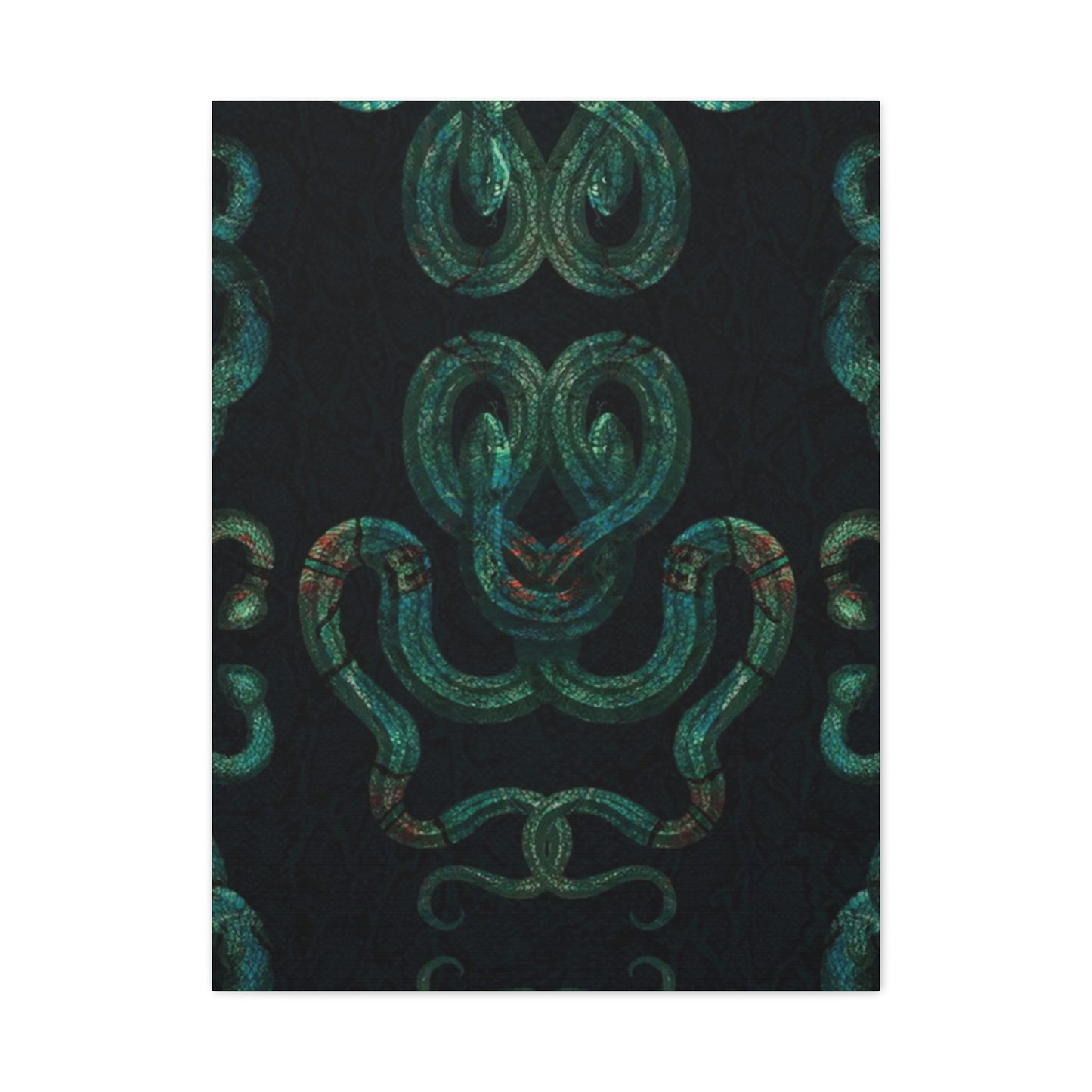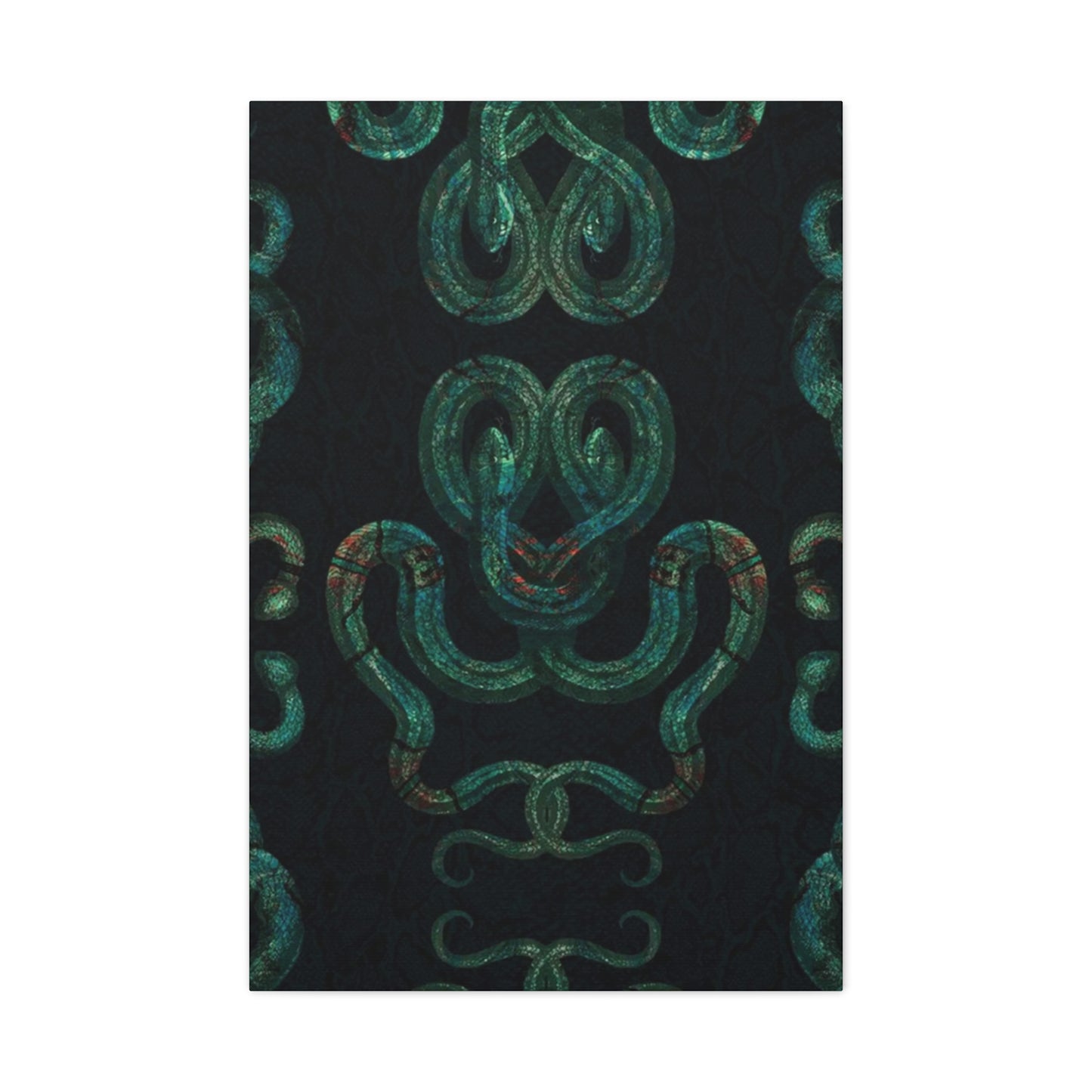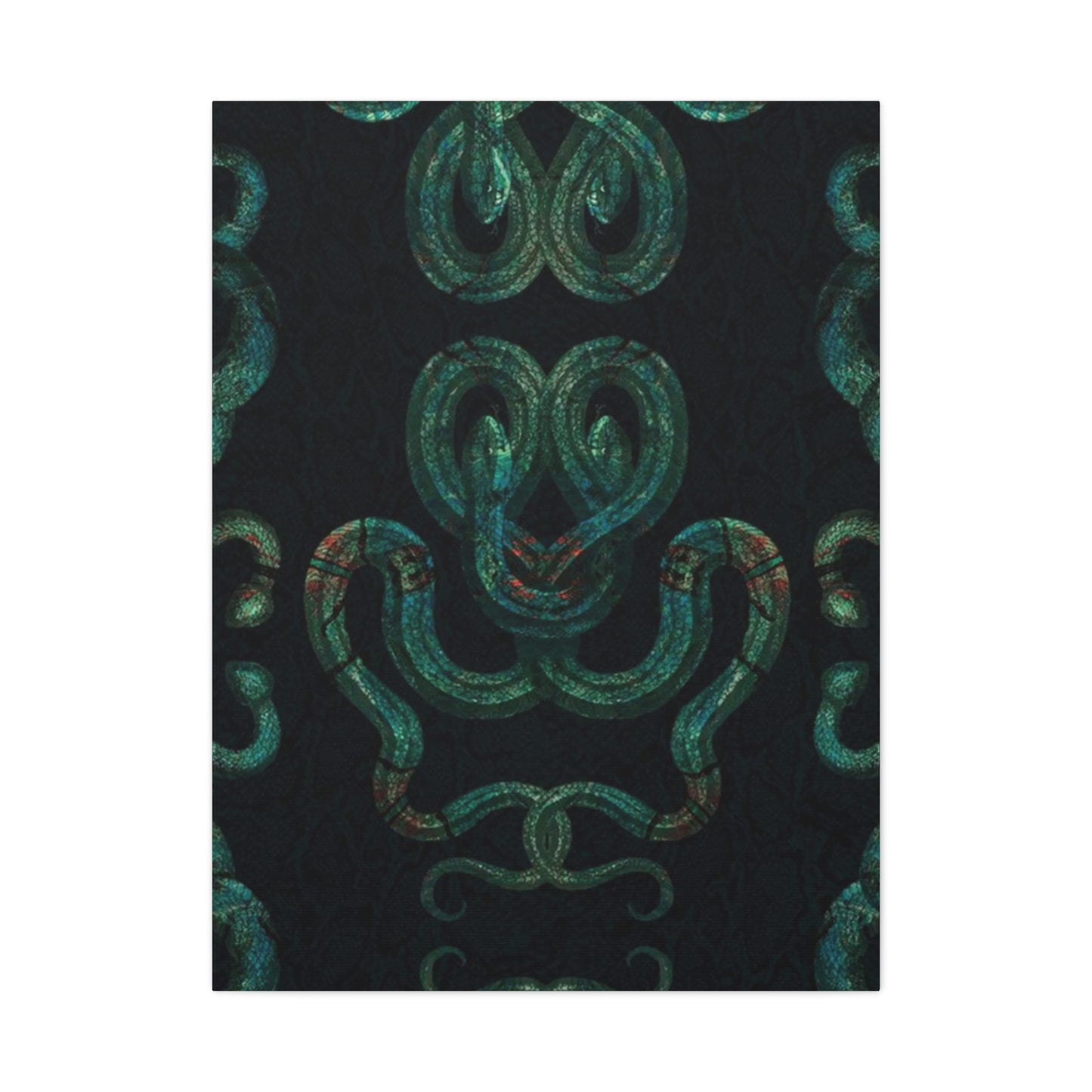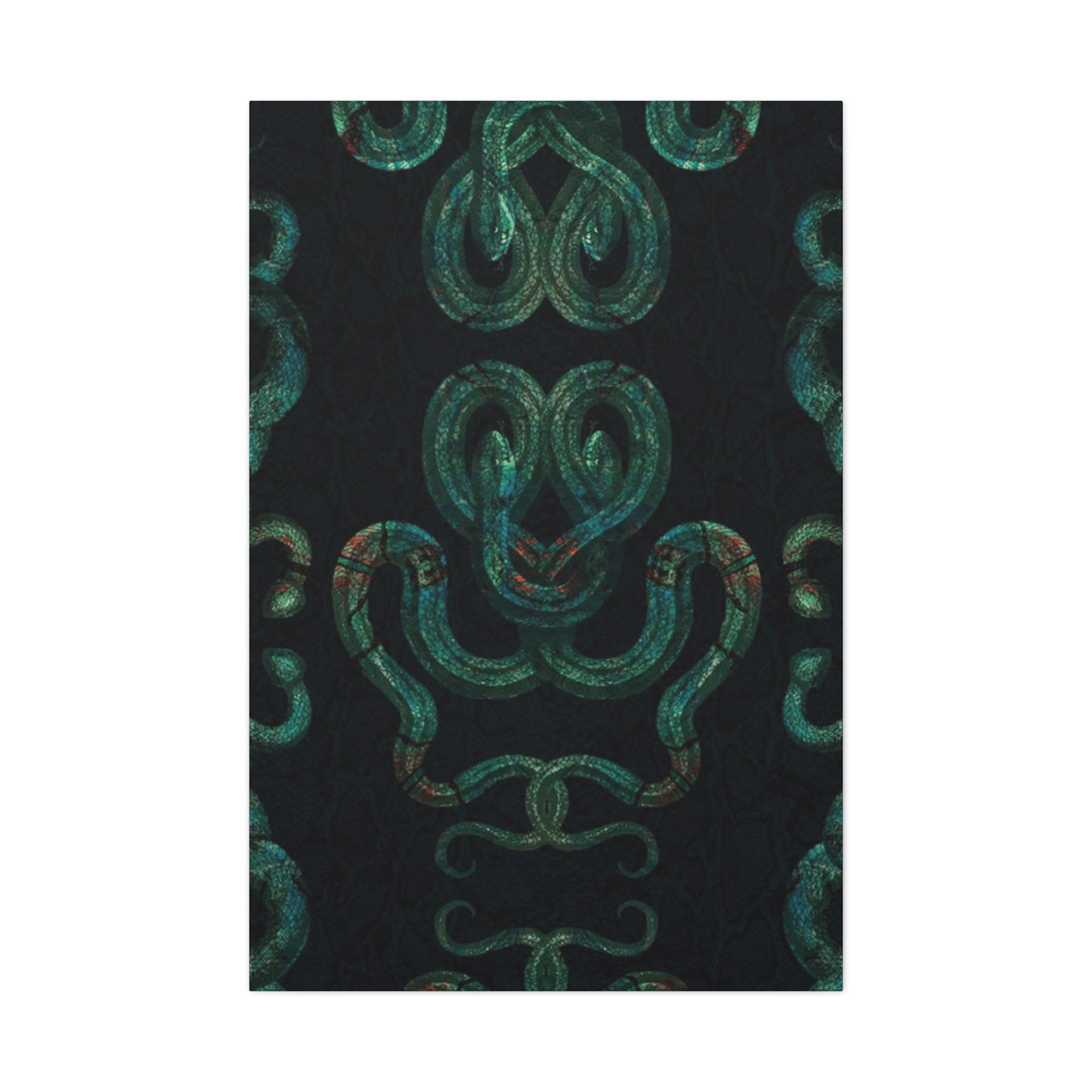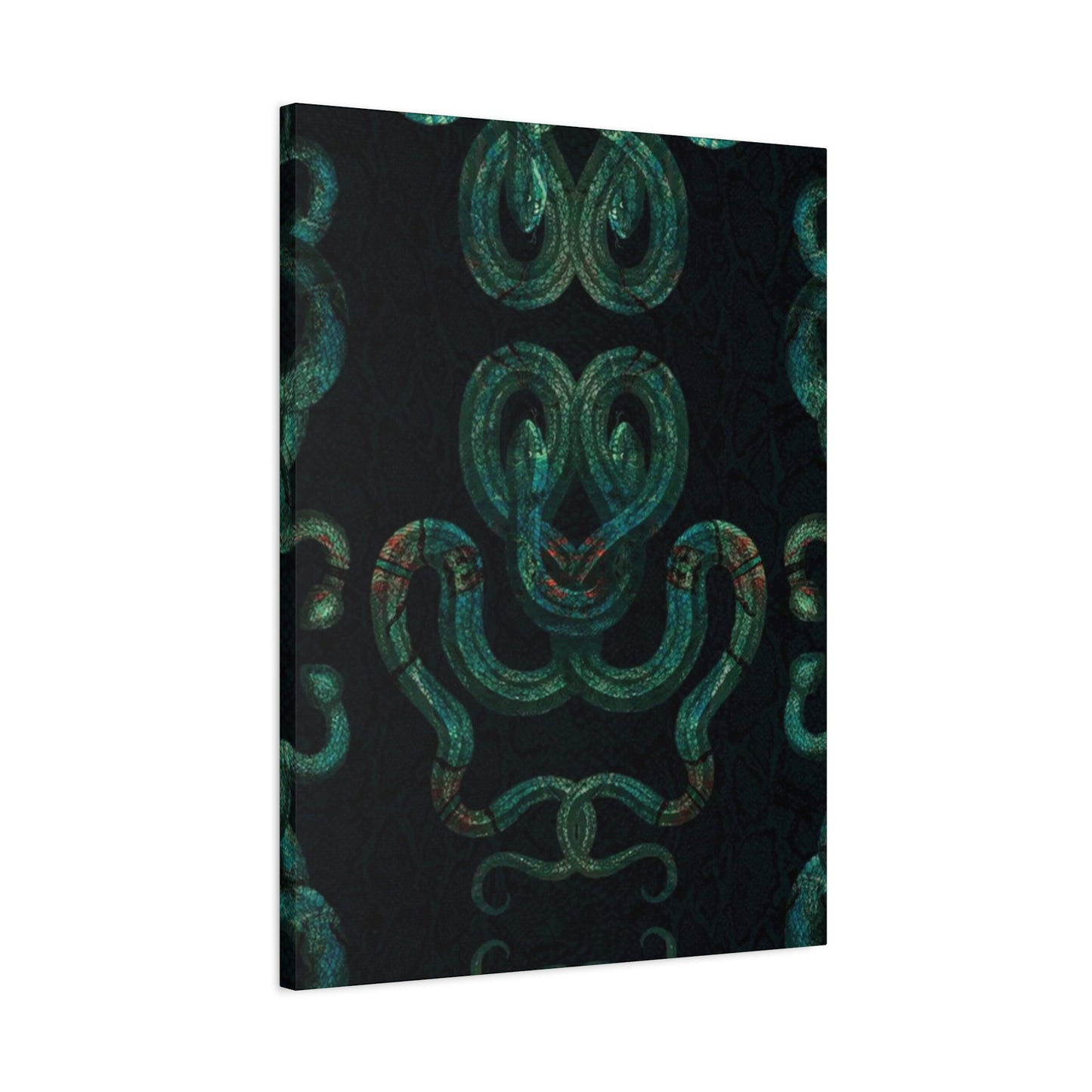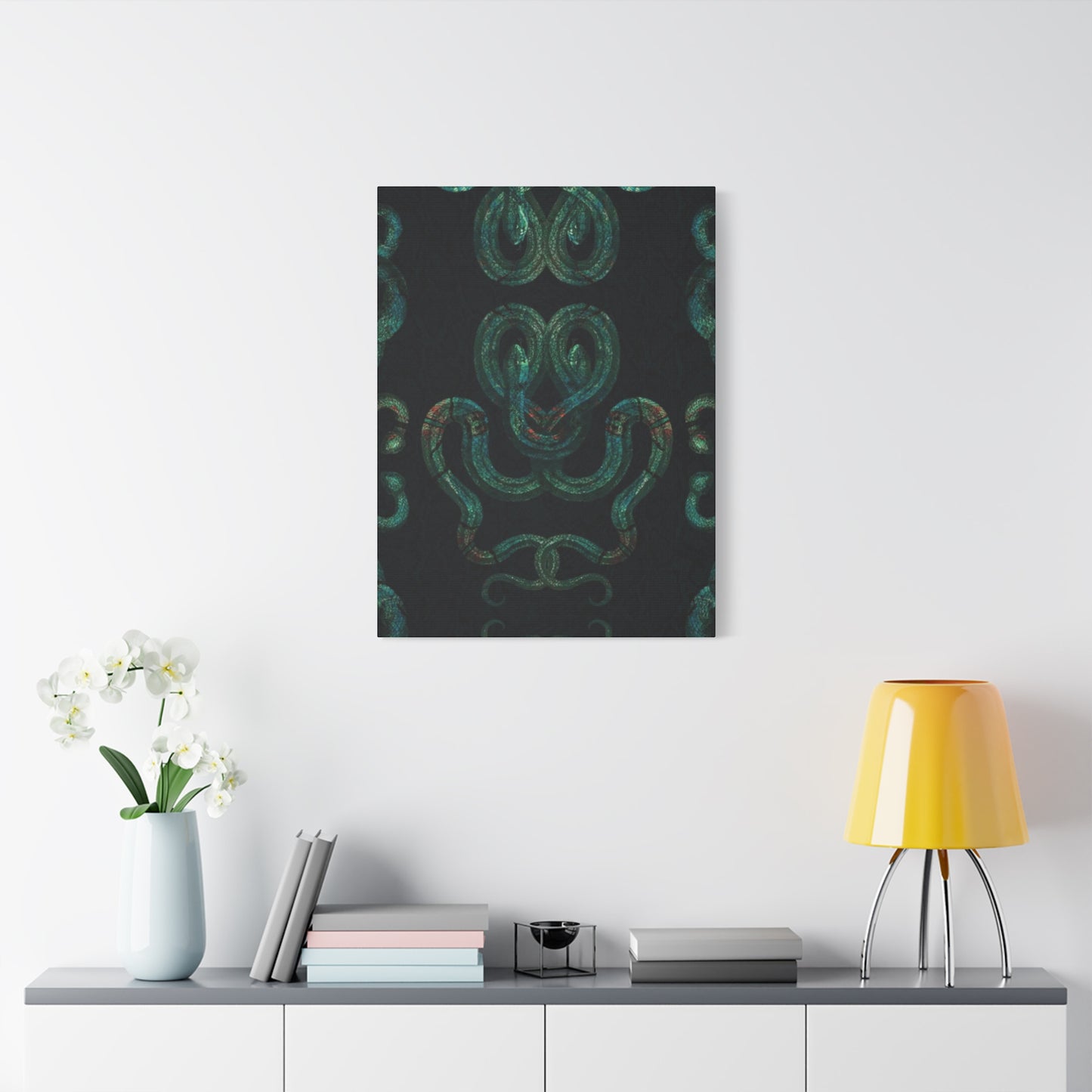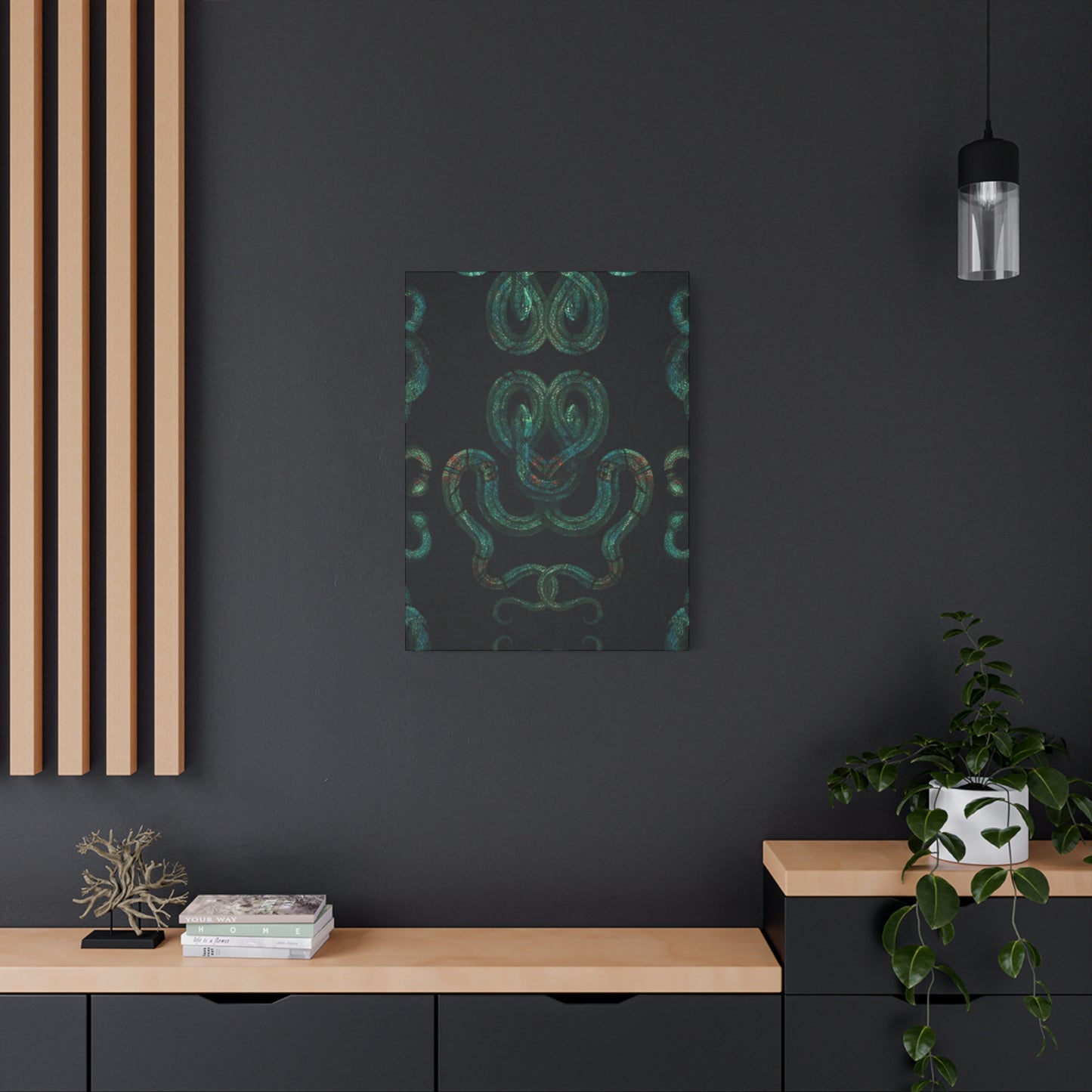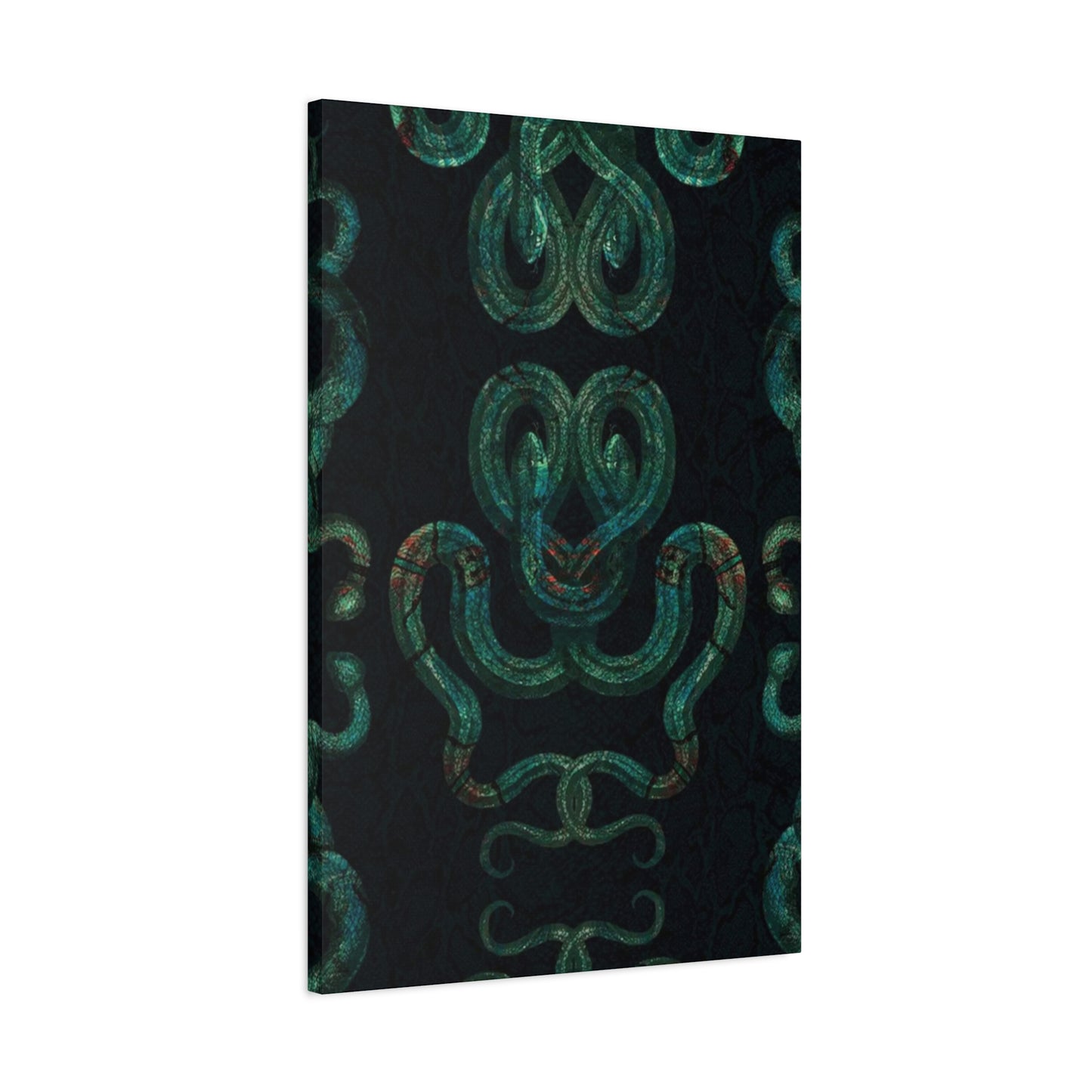Serpentine Mastery: The Captivating World of Entangled Snakes Wall Art
Throughout human civilization, serpents have held profound symbolic meaning across cultures, religions, and artistic movements. The representation of entangled snakes wall art taps into this rich historical tapestry, bringing centuries of meaning into contemporary living environments. From the ouroboros of ancient Egypt to the healing serpents of Greek mythology, snake imagery has consistently represented transformation, wisdom, protection, and the cyclical nature of life.
In modern home decoration, entangled snakes wall art serves as more than mere aesthetic enhancement. These pieces function as conversation starters, meditation focal points, and symbols of personal growth and renewal. The intertwining nature of serpents in artistic representation speaks to the complexity of human relationships, the duality of nature, and the eternal dance between opposing forces. When homeowners choose serpentine artwork, they are unconsciously connecting with archetypal symbols that resonate deep within the collective unconscious.
The visual impact of twisted serpent forms creates dynamic energy within residential environments. Unlike static geometric patterns or traditional landscape paintings, entangled snake designs pulse with implied movement and life force. This kinetic quality makes such artwork particularly effective in areas where energy flow is desired, such as living rooms, meditation areas, or creative workspaces. The sinuous curves and interlocking forms guide the eye through the composition, creating visual journeys that can be explored repeatedly without losing their fascination.
Contemporary artists working in the serpentine tradition often employ various techniques to enhance the mystical qualities of their subjects. Some utilize metallic paints that shimmer and change appearance under different lighting conditions, while others incorporate textured surfaces that invite tactile exploration. Digital artists may layer translucent elements to create depth and mystery, while traditional painters might use chiaroscuro techniques to emphasize the dramatic interplay of light and shadow across serpentine forms.
The psychological impact of serpent imagery varies significantly among individuals, making it essential for homeowners to consider their personal reactions to such powerful symbolism. For some, snakes represent wisdom, healing, and spiritual transformation, making entangled snakes wall art an inspiring daily reminder of personal growth potential. Others may find comfort in the protective symbolism associated with serpents in various cultural traditions, viewing their artwork as spiritual guardians for their living environments.
The placement of entangled snakes wall art requires careful consideration of both aesthetic and energetic factors. These powerful images work exceptionally well as focal points in rooms where contemplation and introspection are valued. Many homeowners find that positioning such artwork in areas visible during daily routines creates opportunities for brief meditative moments throughout the day. The complexity of interwoven serpent forms provides rich visual material for contemplation, offering new details and interpretations with each viewing.
Color psychology plays a crucial role in the effectiveness of serpentine artwork. Deep emerald greens evoke the natural habitat of many snake species while simultaneously connecting to associations with growth, healing, and abundance. Rich burgundy and gold combinations suggest luxury and transformation, while monochromatic schemes in blacks and grays emphasize the mysterious and protective aspects of serpent symbolism. The choice of color palette significantly influences the emotional impact and compatibility with existing decor schemes.
The cultural significance of entangled serpents extends beyond Western interpretations, encompassing rich traditions from around the globe. In Hindu and Buddhist traditions, serpents represent kundalini energy, the powerful spiritual force that lies coiled at the base of the spine. Chinese culture associates dragons and serpents with wisdom, power, and good fortune, making serpentine artwork particularly meaningful for those drawn to Eastern philosophy and aesthetics. Native American traditions often view serpents as symbols of transformation and renewal, connecting to seasonal cycles and natural rhythms.
Modern manufacturing techniques have revolutionized the production and accessibility of high-quality serpentine artwork. Advanced printing technologies allow for reproduction of intricate details and subtle color gradations that were previously achievable only through original paintings. Digital enhancement techniques enable artists to create complex layering effects and dimensional qualities that add depth and visual interest to serpent imagery. These technological advances have made sophisticated entangled snakes wall art available to a broader audience while maintaining artistic integrity and visual impact.
Exploring Different Artistic Styles in Serpentine Wall Decoration
The artistic interpretation of entangled snakes spans numerous stylistic approaches, each offering unique aesthetic possibilities for modern home decoration. Realistic representational styles focus on anatomical accuracy and natural behavior patterns, creating artwork that celebrates the inherent beauty of serpentine forms without additional symbolic layering. These pieces often feature detailed scale patterns, authentic coloration, and natural positioning that showcases the elegant simplicity of snake anatomy.
Abstract interpretations of serpentine themes allow artists to explore the essential qualities of snake movement and form without being constrained by realistic representation. These works might emphasize the flowing, rhythmic qualities of serpent motion through simplified curves and geometric interpretations of coiling patterns. Color becomes a primary vehicle for expression in abstract serpentine art, with artists free to explore palettes that enhance mood and atmosphere rather than mimicking natural coloration.
Contemporary mixed-media approaches to entangled snakes wall art incorporate various materials and techniques to create multi-dimensional experiences. Artists might combine traditional painting with metallic accents, textured surfaces, or three-dimensional elements that extend beyond the picture plane. These innovative approaches create artwork that changes appearance throughout the day as lighting conditions shift, adding dynamic qualities that keep the viewing experience fresh and engaging.
Minimalist interpretations of serpentine themes distill complex entanglement patterns down to their essential elements, creating clean, modern designs that complement contemporary home aesthetics. These pieces might feature simple line work, limited color palettes, and geometric abstraction of coiling forms. The restraint inherent in minimalist approaches allows the fundamental power of serpent symbolism to emerge without visual distraction, making such artwork particularly suitable for modern and contemporary home environments.
Traditional artistic techniques continue to find new expression in serpentine artwork, with many contemporary artists drawing inspiration from historical approaches while incorporating modern sensibilities. Renaissance-style chiaroscuro techniques create dramatic lighting effects that enhance the mysterious qualities of entangled serpent forms. Asian brush painting traditions offer approaches to serpentine subjects that emphasize fluid movement and essential character rather than detailed representation.
Digital art platforms have opened entirely new possibilities for serpentine artistic expression. Artists can create complex animations that bring entangled snake forms to life, though these are typically adapted for static print reproduction. The ability to manipulate and layer digital elements allows for the creation of intricate compositions that would be extremely challenging to achieve through traditional media. Color gradations, transparency effects, and complex pattern overlays become accessible tools for artistic expression.
The influence of various art movements continues to shape contemporary serpentine artwork. Art Nouveau's emphasis on natural forms and flowing lines provides a natural framework for serpent imagery, while the bold colors and simplified forms of Fauvism offer approaches that emphasize emotional impact over realistic representation. Surrealist traditions encourage the exploration of dreamlike and symbolic interpretations of serpentine themes, often combining multiple serpents in impossible or fantastical arrangements.
Street art and graffiti traditions have contributed to the evolution of serpentine imagery, bringing bold, graphic approaches that translate effectively to home decoration. These styles often feature high contrast colors, strong outlines, and simplified forms that create immediate visual impact. The urban aesthetic associated with street art can bring contemporary edge to traditional serpentine symbolism, making such artwork particularly appealing to younger homeowners or those with eclectic decorative tastes.
Photography-based approaches to serpentine artwork capture the natural beauty of living snakes in their environments or in carefully composed studio settings. High-resolution macro photography can reveal intricate details of scale patterns and skin textures that create fascinating abstract compositions when viewed closely. The challenge in photographic serpentine art lies in capturing the dynamic qualities of snake movement in static images, often requiring careful timing and composition to suggest motion and vitality.
Sculpture-inspired flat artwork creates the illusion of three-dimensional serpent forms on two-dimensional surfaces. Artists achieve these effects through careful attention to lighting, shadow, and perspective, creating pieces that seem to extend into the viewer's physical environment. These techniques are particularly effective for large-scale entangled snakes wall art, where the enhanced sense of presence and physicality can create dramatic focal points in residential settings.
Color Theory and Its Application in Serpentine Artwork
The strategic use of color in entangled snakes wall art significantly influences both the aesthetic impact and psychological effect of these powerful images. Understanding color theory principles enables homeowners to select serpentine artwork that not only complements their existing decor but also creates desired emotional responses and energy patterns within their living environments. The natural coloration of serpents provides artists with a rich palette of possibilities, from the vibrant patterns of tropical species to the subtle earth tones of desert-dwelling varieties.
Warm color schemes in serpentine artwork typically employ reds, oranges, yellows, and gold tones that create feelings of energy, passion, and vitality. These palettes work particularly well in social areas where stimulating conversation and active engagement are desired. The use of warm colors in entangled snake designs can symbolize transformation through fire, passion, and creative energy. Artists often employ gradations from deep burgundy through bright orange to golden yellow, creating dynamic compositions that seem to pulse with internal heat and energy.
Cool color palettes featuring blues, greens, and purples offer entirely different psychological effects in serpentine artwork. These colors evoke feelings of calm, wisdom, and spiritual depth, making them suitable for meditation areas, bedrooms, or any environment where tranquility is valued. Cool-toned entangled snakes wall art often incorporates the natural green coloration of many serpent species, connecting viewers to associations with nature, growth, and healing energy. Deep emerald greens combined with sapphire blues can create artwork that seems to glow with mystical energy.
Monochromatic color schemes allow the forms and composition of entangled serpents to take precedence over color relationships. Black and white serpentine artwork creates dramatic, high-contrast images that work well in modern and contemporary home environments. These pieces often emphasize the graphic qualities of interwoven serpent forms, creating bold patterns that function as striking decorative elements. Sepia and other monochromatic approaches can evoke vintage or antique qualities, connecting contemporary serpentine art to historical artistic traditions.
Complementary color relationships in serpentine artwork create visual tension and excitement through the use of colors that sit opposite each other on the color wheel. Artists might combine orange serpents with blue backgrounds, or purple snakes against yellow settings. These high-contrast combinations create vibrant, energetic artwork that demands attention and creates strong focal points in residential environments. The natural iridescence of many serpent species provides inspiration for artists exploring complementary color relationships.
Analogous color schemes use colors that sit adjacent to each other on the color wheel, creating harmonious, cohesive compositions. These approaches might combine various shades of green, blue-green, and blue to create serpentine artwork that feels naturally unified and peaceful. Analogous color schemes work particularly well for homeowners who prefer subtle, sophisticated color relationships that integrate smoothly with existing decorative elements.
The cultural associations of colors add additional layers of meaning to serpentine artwork. In many Western traditions, red serpents might symbolize danger or passion, while green snakes connect to nature and healing. However, these associations vary significantly across cultures, making it important for artists and collectors to consider the cultural context of color choices. Eastern traditions might associate gold serpents with wisdom and spiritual advancement, while white snakes could represent purity or divine energy.
Metallic accents in serpentine artwork add luxury and mystical qualities that enhance the symbolic power of the imagery. Gold highlights can suggest divine energy or solar associations, while silver accents might evoke lunar energy or feminine wisdom. Copper tones can add warmth and earthiness to serpentine compositions, connecting the artwork to associations with transformation through heat and chemical processes. The reflective qualities of metallic elements create artwork that changes appearance throughout the day as lighting conditions shift.
The psychological impact of color saturation in serpentine artwork influences how viewers respond to these powerful images. Highly saturated, vivid colors create energetic, stimulating effects that work well in active living areas or creative workspaces. More muted, desaturated colors offer sophistication and restraint that might be more suitable for bedrooms or formal living areas. The choice of saturation level should align with both the intended use of the room and the homeowner's personal aesthetic preferences.
Gradient and ombré effects in serpentine artwork create sense of movement and transformation that aligns naturally with snake symbolism. Artists might use color gradations to suggest the passage of time, seasonal changes, or spiritual transformation. These techniques can make static artwork appear to pulse with life and energy, enhancing the dynamic qualities inherent in serpentine imagery. Subtle gradations can create atmospheric effects, while dramatic color transitions can emphasize the transformative symbolism associated with serpents.
The interaction between foreground and background colors significantly affects the visual impact of entangled snakes wall art. High contrast between serpent colors and background tones creates bold, graphic effects that work well as statement pieces. More subtle color relationships can create atmospheric, dreamlike qualities that encourage contemplation and meditation. The choice of contrast level influences how the artwork functions within the broader decorative scheme of a room.
Creating Visual Impact with Serpentine Wall Decorations
The successful integration of entangled snakes wall art into residential environments requires careful attention to various techniques that maximize visual impact while maintaining harmony with existing decorative elements. Scale relationships play a crucial role in determining how serpentine artwork functions within a room. Large-scale pieces can serve as dramatic focal points that anchor entire decorative schemes, while smaller works might function as accent pieces that add symbolic meaning and visual interest to specific areas.
The concept of negative space becomes particularly important when working with serpentine imagery. The areas between and around entangled snake forms contribute significantly to the overall composition and visual impact of the artwork. Artists who understand how to balance positive and negative space create compositions that breathe and flow, preventing the complex forms of intertwined serpents from becoming visually overwhelming. Effective use of negative space also allows viewers' eyes to rest and process the symbolic content of the imagery.
Layering techniques in serpentine artwork create depth and visual complexity that keeps viewers engaged over time. Artists might layer translucent serpent forms over background elements, creating depth and mystery that invites closer examination. These approaches work particularly well in digital media, where transparency effects and multiple layer combinations can create intricate, jewel-like compositions. The ability to suggest multiple planes of depth within a two-dimensional artwork enhances the dynamic qualities of entangled snake imagery.
Rhythm and movement patterns in serpentine compositions guide viewers' eyes through the artwork in ways that enhance both aesthetic appreciation and symbolic understanding. The natural S-curves of serpent bodies provide built-in rhythmic elements that artists can emphasize through repetition, variation, and careful compositional planning. These rhythmic patterns can connect individual pieces of serpentine artwork to larger decorative schemes, creating visual flow that extends beyond the boundaries of single artworks.
Texture variations within serpentine artwork add tactile qualities that enhance the sensory appeal of these powerful images. Artists might contrast smooth, polished serpent skin with rough, textured background elements, or incorporate various paint application techniques that create surface variations. These textural contrasts add visual interest and can make artwork more engaging when viewed from different distances and angles.
The strategic use of focal points within complex serpentine compositions prevents viewer confusion while highlighting the most important symbolic or aesthetic elements. Artists might use color contrast, detail concentration, or lighting effects to draw attention to specific areas of entangled snake imagery. These techniques help viewers navigate complex compositions while ensuring that key symbolic elements receive appropriate emphasis.
Proportional relationships between individual serpents within entangled compositions affect both aesthetic balance and symbolic meaning. Artists must carefully consider how different sized serpents interact within the composition, ensuring that no single element dominates inappropriately while maintaining visual interest through variation. These proportional decisions can enhance symbolic meanings, with larger serpents potentially representing dominant themes or energies.
Edge treatment in serpentine artwork influences how pieces integrate with their surrounding environments. Hard, defined edges create separation between artwork and wall surfaces, emphasizing the artwork as a discrete decorative element. Soft, graduated edges can help artwork blend more naturally with surrounding decor, creating more integrated decorative effects. The choice of edge treatment should align with both aesthetic preferences and the desired role of the artwork within the broader decorative scheme.
Lighting considerations significantly affect the appearance and impact of entangled snakes wall art throughout different times of day and under various artificial lighting conditions. Artists who understand how their chosen colors and techniques will appear under different lighting situations can create artwork that maintains its impact regardless of viewing conditions. Some serpentine artwork is specifically designed to change appearance under different lighting, creating dynamic decorative elements that evolve throughout the day.
The integration of serpentine artwork with architectural elements requires careful attention to scale, proportion, and visual weight relationships. Large architectural features like fireplaces, built-in bookcases, or prominent windows create opportunities for serpentine artwork placement that enhances both the architecture and the artwork. Understanding how to balance the visual weight of complex serpentine imagery with architectural elements prevents conflicts while creating harmonious integrated designs.
Pattern recognition and variation techniques help artists create serpentine compositions that maintain viewer interest without becoming repetitive or monotonous. While the coiling, intertwining nature of serpent forms creates natural pattern elements, artists must vary these patterns enough to prevent visual boredom while maintaining enough consistency to create unified compositions. This balance between pattern and variation requires sophisticated understanding of visual perception and composition principles.
Serpentine Symbolism in Home Environments
The incorporation of entangled snakes wall art into residential environments taps into deep psychological associations that have developed over millennia of human interaction with serpentine symbolism. Understanding these psychological dimensions helps homeowners make informed decisions about serpentine artwork while maximizing the positive impacts of these powerful images on daily life and personal well-being. The archetypal nature of serpent symbolism means that responses to such imagery often occur at subconscious levels, influencing mood, thought patterns, and behavior in subtle but significant ways.
Carl Jung's research into archetypal symbols identified the serpent as one of the most universally significant images in human consciousness. The appearance of serpents in dreams, mythology, and artistic expression across cultures suggests that these creatures tap into fundamental aspects of human psychology that transcend individual experience. When homeowners choose entangled snakes wall art, they are connecting with these archetypal energies, potentially accessing sources of wisdom, transformation, and personal power that lie dormant in everyday consciousness.
The dual nature of serpent symbolism creates complex psychological effects that can vary significantly among individuals. While some people respond to snake imagery with fear or discomfort based on evolutionary conditioning or personal experiences, others find serpentine symbols deeply compelling and empowering. This variability makes it essential for homeowners to examine their personal reactions to serpent imagery before incorporating such powerful symbols into their daily living environments.
The concept of transformation inherent in serpent symbolism can have profound psychological effects on individuals navigating periods of personal change or growth. The natural process of snake shedding, where serpents literally outgrow their old skin to reveal fresh, new surfaces beneath, provides a powerful metaphor for personal renewal and transformation. Daily exposure to entangled snakes wall art can serve as subtle but consistent reminders of the possibility and necessity of personal growth and change.
The healing associations of serpent symbolism, exemplified by the medical caduceus and the rod of Asclepius, connect to deep psychological patterns related to wholeness and integration. For individuals working through personal challenges, recovering from illness, or seeking to integrate different aspects of their personalities, serpentine artwork can serve as symbolic support for healing processes. The intertwined nature of entangled serpents might particularly resonate with individuals working to balance opposing forces or integrate conflicting aspects of their lives.
The protective symbolism associated with serpents in many cultural traditions can create feelings of security and strength for homeowners who resonate with these meanings. In various mythological systems, serpents serve as guardians of sacred places, treasures, or wisdom. Individuals who connect with these protective aspects might find that entangled snakes wall art creates subtle feelings of safety and spiritual protection within their living environments.
The wisdom associations of serpent symbolism tap into psychological patterns related to intuitive knowledge and hidden understanding. Serpents are often depicted as keepers of secret knowledge or forbidden wisdom in mythological traditions. For individuals engaged in learning, spiritual development, or creative endeavors, serpentine artwork might serve as inspiration for accessing deeper levels of understanding and insight.
The cyclical nature of serpentine symbolism, exemplified by the ouroboros image of a serpent eating its own tail, connects to psychological patterns related to life cycles, renewal, and eternal return. These themes can be particularly meaningful for individuals navigating major life transitions, seasonal changes, or spiritual development phases. The presence of serpentine imagery can serve as daily reminders of the cyclical nature of existence and the continuous possibility of renewal.
The energy and vitality associated with serpent movement and behavior can have stimulating psychological effects on residents of environments decorated with serpentine artwork. The implied motion inherent in images of entangled snakes can create subtle energetic effects that counteract feelings of stagnation or lethargy. For individuals working in creative fields or those seeking to increase motivation and drive, serpentine artwork might provide symbolic support for dynamic action and forward movement.
The mystery and depth often associated with serpent symbolism can appeal to individuals drawn to exploring the unknown aspects of life and consciousness. The complex, intertwined forms typical of entangled snakes wall art invite contemplation and deeper examination, potentially supporting meditative practices and introspective activities. These qualities make serpentine artwork particularly suitable for individuals engaged in personal development work or spiritual practices.
The primal, instinctual associations of serpent imagery can help individuals reconnect with fundamental aspects of human nature that may be suppressed in modern, technological society. Daily exposure to serpentine symbolism might support efforts to maintain connection with natural rhythms, instinctual wisdom, and essential life force energy. This connection can be particularly valuable for individuals whose work or lifestyle tends to disconnect them from natural patterns and cycles.
Perfect Serpentine Artwork for Different Room Types
The successful integration of entangled snakes wall art requires careful consideration of how different room functions, traffic patterns, and energy needs interact with the powerful symbolism and visual impact of serpentine imagery. Each room type presents unique opportunities and challenges for serpentine artwork placement, making it essential to match artwork characteristics with specific environmental requirements and usage patterns.
Living room environments offer excellent opportunities for large-scale entangled snakes wall art that serves as conversation focal points and symbolic anchors for social gathering areas. These communal environments can handle the dramatic visual impact of complex serpentine compositions, while the symbolic associations of transformation and wisdom can enhance the intellectual and social exchanges that occur in living areas. The placement of serpentine artwork above seating areas creates natural focal points that draw attention without overwhelming conversation areas.
The scale considerations for living room serpentine artwork typically favor larger pieces that can command attention across the expansive sight lines common in these multi-functional environments. However, the complexity of entangled snake imagery must be balanced against the need for artwork that doesn't become visually overwhelming during extended viewing periods. Medium complexity compositions often work best, providing enough visual interest to sustain attention while remaining comfortable for daily exposure.
Bedroom environments require more careful consideration of serpentine imagery due to the intimate, personal nature of these private retreat areas. The transformative symbolism of serpent imagery can be particularly meaningful in bedrooms, where rest and renewal occur naturally. However, the visual complexity and symbolic intensity of entangled snakes wall art must be balanced against the need for restful, calming environments that support quality sleep and relaxation.
For bedroom applications, serpentine artwork with softer color palettes and more flowing, less aggressive compositions typically work best. The placement of such artwork in areas visible from the bed can provide meditative focal points for morning and evening reflection, while positioning pieces away from direct sight lines from sleeping areas prevents potential sleep disruption from overly stimulating imagery.
Home office environments can benefit significantly from the wisdom and transformation symbolism associated with serpentine imagery, particularly for individuals engaged in creative work, learning, or personal development activities. The dynamic visual qualities of entangled snake compositions can provide inspiration and energy support for mental work, while the archetypal associations of serpents with hidden knowledge can symbolically support learning and discovery processes.
The placement of serpentine artwork in home offices should consider sight lines from primary work areas, ensuring that the artwork provides inspiration without becoming distracting during focused work periods. Medium-scale pieces often work well in office environments, providing symbolic support without overwhelming the practical requirements of work areas. The color choices for office serpentine artwork should complement lighting conditions and support sustained concentration rather than creating visual fatigue.
Dining room applications of serpentine artwork can enhance the social and nourishing aspects of shared meals while connecting to the life force and vitality symbolism associated with serpent imagery. The cyclical nature of eating and nourishment aligns naturally with the renewal and transformation themes inherent in serpentine symbolism. However, the imagery must be carefully selected to enhance rather than inhibit appetite and social comfort.
Entangled snakes wall art in dining areas works best when the compositions emphasize flowing, organic forms rather than aggressive or threatening imagery. The color palettes should complement food presentation and social interaction, typically favoring warmer, more inviting tones rather than stark or cold color schemes. The scale should be appropriate for intimate dining conversations while providing enough visual interest to enhance the dining experience.
Kitchen environments present unique challenges for serpentine artwork due to practical considerations related to cooking activities, cleaning requirements, and food safety concerns. However, the life force and nourishment symbolism associated with serpents can align well with the sustaining activities that occur in kitchen environments. The key is selecting serpentine artwork that enhances the positive energy of food preparation while withstanding the practical demands of kitchen use.
For kitchen applications, serpentine artwork should be positioned away from direct exposure to cooking activities while remaining visible enough to contribute to the overall energy of the environment. Smaller scale pieces often work better in kitchens due to the typical abundance of practical elements that compete for visual attention. The artwork should complement rather than compete with the functional requirements of kitchen design.
Bathroom environments might seem challenging for serpentine artwork, but the renewal and cleansing symbolism associated with serpent shedding can align well with the cleansing and renewal activities that occur in bathroom environments. The transformation themes inherent in serpentine imagery can provide symbolic support for personal grooming and self-care routines that occur in these private environments.
The practical requirements of bathroom environments demand serpentine artwork that can withstand humidity and moisture while maintaining visual appeal. The scale and complexity should be appropriate for the typically smaller dimensions of bathroom environments, while the symbolic content should enhance rather than overwhelm the personal, private nature of these environments.
Hallway and transitional area applications of serpentine artwork can take advantage of the movement and journey symbolism inherent in serpent imagery. These transitional zones provide opportunities for serpentine artwork that guides movement through the home while providing symbolic support for the transitions that occur as people move between different functional areas of their living environments.
Cultural Perspectives on Serpentine Imagery Across Global Traditions
The universal appearance of serpent symbolism across diverse cultural traditions provides rich context for understanding how entangled snakes wall art can function within contemporary home environments while honoring historical and cultural meanings. This global perspective reveals both the consistent archetypal power of serpentine imagery and the specific cultural variations that influence interpretation and application of serpent symbolism in modern decorative contexts.
Ancient Egyptian civilization elevated serpent symbolism to divine status through imagery like the ouroboros and the protective uraeus worn by pharaohs. The ouroboros, depicting a serpent consuming its own tail, represented eternal return, cyclical time, and the unity of opposites. For modern homeowners drawn to Egyptian symbolism, entangled snakes wall art can connect to these profound concepts of eternal renewal and cosmic unity. The protective aspects of Egyptian serpent symbolism suggest that such artwork might serve as spiritual guardians for contemporary living environments.
The sophisticated understanding of serpent energy in Egyptian tradition extended to practical applications in architecture and decorative arts. Temple walls frequently featured serpentine imagery designed to channel and direct spiritual energy throughout sacred environments. This historical precedent provides validation for contemporary homeowners seeking to use entangled snakes wall art to influence the energetic qualities of their living environments.
Greek and Roman traditions contributed complex serpentine symbolism that continues to influence Western interpretations of snake imagery. The healing serpents associated with Asclepius established enduring connections between serpents and medical wisdom, while the Caduceus of Hermes combined serpentine imagery with themes of communication, trade, and divine messaging. These classical associations suggest that entangled snakes wall art might be particularly meaningful for individuals in healing professions or those engaged in communication-based work.
The Greek tradition of serpents guarding sacred places and treasures provides additional context for contemporary applications of serpentine artwork. The protective functions of serpents in classical mythology suggest that entangled snakes wall art might serve similar guardian roles in modern home environments, providing symbolic protection for family treasures, whether material or spiritual.
Hindu and Buddhist traditions offer perhaps the most sophisticated understanding of serpentine energy through concepts like kundalini and naga symbolism. The kundalini serpent, coiled at the base of the spine, represents dormant spiritual energy that can be awakened through proper practice and understanding. For practitioners of yoga, meditation, or other Eastern spiritual disciplines, entangled snakes wall art can serve as visual reminders of this powerful spiritual potential.
The naga tradition in Hindu and Buddhist cultures depicts serpents as wise, powerful beings capable of both destruction and protection. These semi-divine serpents guard treasures and sacred knowledge while serving as bridges between earthly and divine realms. Contemporary homeowners drawn to Eastern philosophy might find that entangled snakes wall art connects them to these profound spiritual traditions while honoring the wisdom and power associated with serpentine consciousness.
Chinese cultural traditions associate serpents and dragons with wisdom, transformation, and good fortune, making serpentine artwork potentially auspicious for home environments designed according to feng shui principles. The Chinese zodiac includes the snake as one of the twelve primary animal signs, associated with wisdom, intuition, and mysterious power. Individuals born in snake years or those drawn to Chinese cultural traditions might find particular resonance with entangled snakes wall art.
The flowing, dynamic qualities of serpentine forms align well with feng shui principles related to chi energy flow through living environments. The curved, organic lines typical of entangled snake imagery can help soften harsh architectural angles while promoting smooth energy circulation throughout home environments. This practical application of serpentine symbolism provides additional justification for incorporating such artwork into contemporary home design.
Native American traditions across numerous tribes incorporate serpent symbolism related to transformation, healing, and connection to earth energy. The rainbow serpent figures prominently in many tribal traditions, representing the life-giving power of water and the transformative energy of seasonal change. For individuals drawn to Native American spirituality or those seeking to honor indigenous wisdom traditions, entangled snakes wall art can serve as respectful acknowledgment of these profound cultural teachings.
The earth connection emphasized in many Native American serpent traditions suggests that serpentine artwork might be particularly appropriate for individuals seeking to strengthen their relationship with natural cycles and environmental consciousness. The transformative aspects of serpent symbolism in these traditions align with contemporary concerns about personal growth and environmental stewardship.
African cultural traditions encompass diverse approaches to serpent symbolism, from the rainbow serpent of West African traditions to the protective serpents featured in various regional mythologies. The life-giving and protective aspects of African serpent symbolism provide positive context for contemporary applications of entangled snakes wall art in home environments where family protection and prosperity are valued.
The community-oriented aspects of many African serpent traditions suggest that entangled snakes wall art might be particularly meaningful in family gathering areas or environments where extended family and community connections are important. The protective symbolism can extend to safeguarding family unity and cultural continuity across generations.
Celtic traditions incorporated serpent symbolism related to wisdom, healing, and connection to otherworldly realms. The intertwining patterns common in Celtic art align naturally with entangled snake imagery, providing aesthetic and symbolic connections for individuals drawn to Celtic cultural heritage. The mystical qualities associated with Celtic serpent symbolism can enhance the otherworldly, transformative aspects of contemporary serpentine artwork.
Modern interpretations of global serpent traditions allow contemporary homeowners to select serpentine artwork that honors specific cultural connections while remaining appropriate for multicultural, contemporary home environments. The universal nature of serpent symbolism means that entangled snakes wall art can function effectively across diverse cultural contexts while maintaining respect for traditional meanings and associations.
Displaying Serpentine Wall Art
The successful display of entangled snakes wall art requires attention to numerous technical factors that influence both the longevity of the artwork and its visual impact within residential environments. Understanding these practical considerations ensures that serpentine artwork maintains its aesthetic and symbolic power while withstanding the environmental challenges present in typical home settings.
Lighting design plays a crucial role in maximizing the visual impact of serpentine artwork while protecting the materials from damage caused by excessive or inappropriate illumination. The complex forms and intricate details typical of entangled snake imagery benefit from lighting that emphasizes texture and dimensional qualities without creating harsh shadows or glare that obscures important visual elements. LED lighting systems offer excellent control over color temperature and intensity while generating minimal heat that could damage artwork over time.
The directionality of lighting significantly affects how serpentine artwork appears throughout different times of day and under various viewing conditions. Side lighting can emphasize textural qualities and create dramatic shadow effects that enhance the three-dimensional appearance of flat artwork, while front lighting provides even illumination that reveals color and detail without creating excessive shadows. The choice of lighting approach should align with both aesthetic preferences and practical considerations related to room function and traffic patterns.
UV protection becomes particularly important for serpentine artwork that incorporates organic pigments or materials susceptible to light damage. Museum-quality UV filtering glass or acrylic glazing materials can provide essential protection without significantly affecting visual clarity or color accuracy. For high-value or irreplaceable serpentine artwork, the investment in protective glazing materials provides insurance against long-term damage from accumulated light exposure.
Humidity control affects the stability and longevity of serpentine artwork, particularly pieces created with natural materials or traditional techniques. Fluctuating humidity levels can cause expansion and contraction cycles that stress artwork materials and mounting systems. Maintaining stable humidity levels between 45-55% typically provides optimal conditions for most artwork materials while remaining comfortable for human habitation.
Temperature stability complements humidity control in creating optimal conditions for serpentine artwork display. Rapid temperature changes or extreme temperatures can cause materials to expand and contract at different rates, potentially causing cracking, warping, or other structural damage. Avoiding placement near heating vents, fireplaces, or windows that receive direct sunlight helps maintain stable temperature conditions that protect artwork integrity.
Mounting systems for serpentine artwork must accommodate both aesthetic requirements and structural demands while providing security against accidental damage or theft. Traditional wire hanging systems work well for lighter pieces, while heavier artwork might require more substantial mounting hardware designed to distribute weight across larger wall areas. The choice of mounting system should consider both current needs and potential future relocation requirements.
The wall surfaces chosen for serpentine artwork display affect both aesthetic integration and practical performance. Textured wall surfaces can create interesting visual interactions with serpentine imagery but might also create shadows or visual conflicts that compete with artwork details. Smooth wall surfaces typically provide neutral backgrounds that allow serpentine artwork to command full attention while simplifying cleaning and maintenance requirements.
Air circulation around serpentine artwork helps prevent the accumulation of dust, pollutants, and moisture that can cause gradual deterioration over time. Avoiding placement in areas with poor air circulation or high pollutant loads helps preserve artwork materials while maintaining optimal visual appearance. Regular, gentle cleaning according to appropriate conservation principles extends artwork life while maintaining aesthetic impact.
Security considerations become important for valuable serpentine artwork, particularly pieces that might be targeted for theft due to their material value or artistic significance. Discrete security systems can provide protection without compromising aesthetic integration, while insurance considerations might influence decisions about display location and protective measures.
Conclusion
The world of entangled snakes wall art offers a mesmerizing exploration of symbolism, artistry, and dynamic design that captivates viewers and transforms any space into a statement of power and mystery. Serpents have long held a rich place in human culture, representing everything from transformation and rebirth to protection and wisdom. When captured through the intricate imagery of entwined snakes, these artworks weave together narratives that are both ancient and timeless, inviting reflection on the complex balance between danger and beauty.
Entangled snakes in wall art create a visual tension that is both hypnotic and evocative. Their twisting forms suggest movement, fluidity, and interconnectedness—qualities that resonate with many aspects of life, including the cycles of nature and the duality of existence. This dynamic interplay makes serpentine art an ideal choice for those seeking to infuse their home or workspace with a sense of depth and energy. Whether rendered in bold, graphic styles or delicate, detailed realism, these pieces command attention and provoke thought.
Beyond their striking aesthetic appeal, entangled snakes hold deep symbolic meaning. They evoke themes of healing, renewal, and the shedding of old skin to make way for growth. This symbolism can inspire viewers to embrace change, confront fears, and tap into their inner strength. For many, displaying snake-themed art becomes a personal talisman, a reminder of resilience and transformation amid life’s twists and turns.
The versatility of serpentine wall art allows it to fit seamlessly into diverse decor styles. From modern minimalist spaces to eclectic or bohemian interiors, snake imagery adds a touch of mystique and sophistication. The fluid lines and intricate patterns of entangled snakes offer endless opportunities for creative expression, whether through monochromatic palettes, vibrant colors, or mixed media techniques.
In conclusion, serpentine mastery in the form of entangled snakes wall art is more than just decoration—it is a celebration of complexity, power, and rebirth. These artworks invite us to explore the beauty in chaos and the strength found in unity. By incorporating such compelling imagery into your environment, you not only enhance the visual impact of your space but also embrace the profound symbolism snakes represent across cultures and time. Embrace the captivating world of serpentine art and let its mesmerizing forms inspire and empower you every day.









